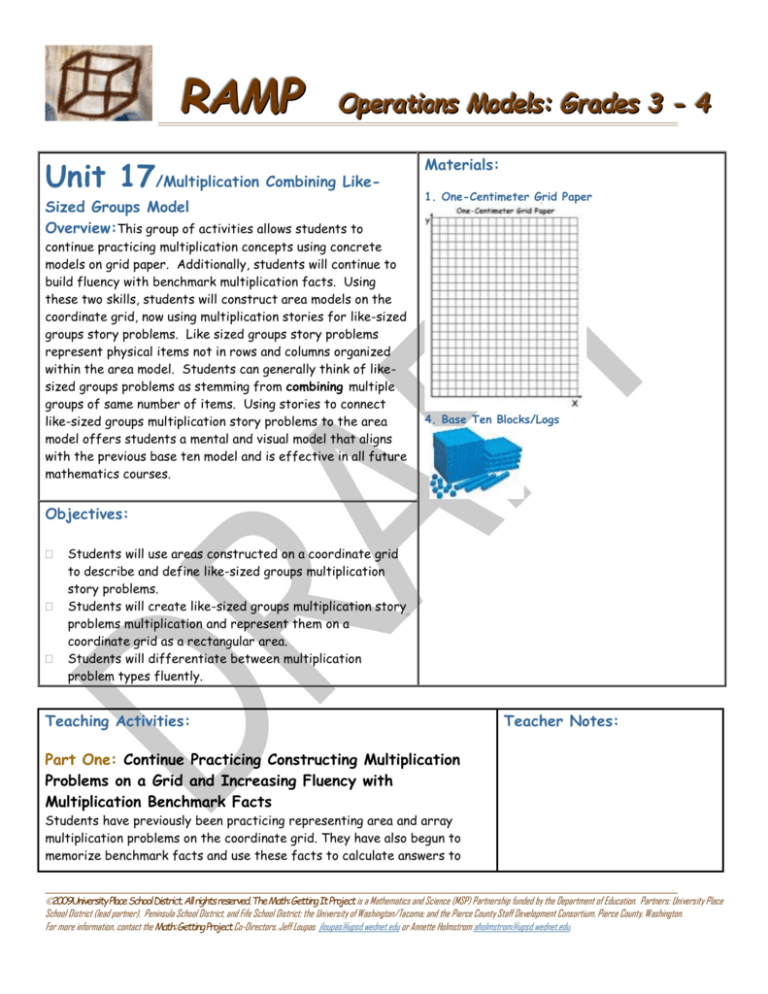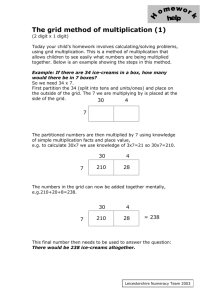
RAMP
Operations Models: Grades 3 - 4
Unit 17/Multiplication Combining LikeSized Groups Model
Overview:This group of activities allows students to
continue practicing multiplication concepts using concrete
models on grid paper. Additionally, students will continue to
build fluency with benchmark multiplication facts. Using
these two skills, students will construct area models on the
coordinate grid, now using multiplication stories for like-sized
groups story problems. Like sized groups story problems
represent physical items not in rows and columns organized
within the area model. Students can generally think of likesized groups problems as stemming from combining multiple
groups of same number of items. Using stories to connect
like-sized groups multiplication story problems to the area
model offers students a mental and visual model that aligns
with the previous base ten model and is effective in all future
mathematics courses.
Materials:
1. One-Centimeter Grid Paper
4. Base Ten Blocks/Logs
Objectives:
Students will use areas constructed on a coordinate grid
to describe and define like-sized groups multiplication
story problems.
Students will create like-sized groups multiplication story
problems multiplication and represent them on a
coordinate grid as a rectangular area.
Students will differentiate between multiplication
problem types fluently.
Teaching Activities:
Teacher Notes:
Part One: Continue Practicing Constructing Multiplication
Problems on a Grid and Increasing Fluency with
Multiplication Benchmark Facts
Students have previously been practicing representing area and array
multiplication problems on the coordinate grid. They have also begun to
memorize benchmark facts and use these facts to calculate answers to
2009University Place School District. All rights reserved. The Math: Getting It Project is a Mathematics and Science (MSP) Partnership funded by the Department of Education. Partners: University Place
School District (lead partner), Peninsula School District, and Fife School District; the University of Washington/Tacoma; and the Pierce County Staff Development Consortium, Pierce County, Washington.
For more information, contact the Math:Getting Project Co-Directors, Jeff Loupas jloupas@upsd.wednet.edu or Annette Holmstrom aholmstrom@upsd.wednet.edu,
RAMP
Operations Models: Grades 3 - 4
simple, related problems. For example, students will use the benchmark 5
X 7 = 35 to solve 6 X 7 (just one more 7). Students will need to continue
practicing these skills as they learn all multiplication problem types.
Part Two: Representing Like-Sized Groups Multiplication
Stories on a Grid and Creating Like-Sized Groups Problems
Describing an Area
The teacher will represent benchmark areas on a grid using an ELMO or
overhead projector, drawing pictures or placing physical items in each box.
For example, the teacher presents the benchmark 5 X 2 drawing candy
from five piles of 2 in each box. The teacher then tells a story about five
piles of candy with two in each pile, asking how students can quickly use the
benchmark rectangles to solve the problem.
After practicing many like-sized groups problems on the grid and creating
stories, the teacher asks students to represent problems on their own grid
to find solutions with appropriate labels (units). For example, students will
represent 6 kennels with 5 dogs in each by drawing in the benchmark area
on a grid. The teacher asks, “How many are there all together?” The
teacher must model the use of labels and urge the use of labels in student
answers. For example, when the student answers “30” to the question
above, the teacher responds, “30 dogs. Don’t forget to tell me what the
labels are so I don’t think we have 30 rooms or 30 of some other item.” It
is imperative for division concepts later (especially remainders and
fractional parts of units) that students use such language to apply area grid
concepts.
Students are then urged to create their own like-sized groups stories and
demonstrate them using the area-grid model. These representations allow
the teacher to reinforce the associative nature of multiplication as well.
Part Three: Students Differentiate Between Multiplication
Story Types
The students will differentiate between multiplication problem types as
presented by the teacher in stories. Students will identify area, array, and
like-sized groups problems. Once students have mastery of these three
problem types, teachers should reintroduce addition and subtraction
problems to increase student fluency across all operations.
2009University Place School District. All rights reserved. The Math: Getting It Project is a Mathematics and Science (MSP) Partnership funded by the Department of Education. Partners: University Place
School District (lead partner), Peninsula School District, and Fife School District; the University of Washington/Tacoma; and the Pierce County Staff Development Consortium, Pierce County, Washington.
For more information, contact the Math:Getting Project Co-Directors, Jeff Loupas jloupas@upsd.wednet.edu or Annette Holmstrom aholmstrom@upsd.wednet.edu,
RAMP
Operations Models: Grades 3 - 4
2009University Place School District. All rights reserved. The Math: Getting It Project is a Mathematics and Science (MSP) Partnership funded by the Department of Education. Partners: University Place
School District (lead partner), Peninsula School District, and Fife School District; the University of Washington/Tacoma; and the Pierce County Staff Development Consortium, Pierce County, Washington.
For more information, contact the Math:Getting Project Co-Directors, Jeff Loupas jloupas@upsd.wednet.edu or Annette Holmstrom aholmstrom@upsd.wednet.edu,








